Tanks in the Cold War
The examples and perspective in this articlemay not represent aworldwide viewof the subject.(April 2012) |
Tank developmentboth evolved considerably fromWorld War IIand played a key role during theCold War(1945–1990). The period pitted the nations of theEastern Bloc(organized under theWarsaw Pactin 1955) and the North Atlantic Treaty Organization (NATO) (since 1949) against each other.
After World War II, tank design budgets were cut and engineering staff was often scattered. Many war planners[who?]believed that with the advent of nuclear weapons the tank was obsolete, given that atactical nuclear weaponcould destroy any brigade or regiment, whether it was armoured or not.
In spite of this, tanks would not only continue to be produced in huge numbers, but the technology advanced dramatically as well. Tanks became larger and advances inarmourmade it much more effective. Aspects of gun technology changed significantly as well, with advances in shell design and terminal effectiveness.
Sovietdomination of the Warsaw Pact led to effective standardization on a few tank designs. Oppositely, the key NATO nations – theUS,UK,France,andWest Germany– all developed their own tank designs. These had little in common, with smaller NATO nations purchasing or adapting one or more of these designs.
TheKorean Warproved that tanks were still useful on the battlefield, given the hesitation of the great powers to usenuclear weapons.In the 1950s, many nations' tanks were equipped withNBC(nuclear, biologic, and chemical) protection, allowing mechanized units to defend against all three types of weapon, or to conduct breakthroughs by exploiting battlefield nuclear strikes.
The decades since have seen continual improvements in tank design, but no fundamental change. Among these have been larger yet guns, correspondingly improved armor systems, and refinements to targeting and ranging (fire control), gun stabilisation, communications and crew comfort.
Transition to main battle tanks[edit]
During and after World War II some medium tanks designs, such as the AmericanM26and SovietT-44,were mass produced before the concept of amain battle tankidea had evolved. These were highly similar to early main battle tanks, with powerful guns, moderate armor, and decent mobility. Their successors, theM46 PattonandT-54,followed suit before the main battle tank doctrine was fully accepted.
Development of the main battle tank[edit]

Medium tanksgradually evolved into the new concept of themain battle tank.This transition happened gradually in the 1950s, as it was realized that medium tanks could carry guns (such as the US90 mm gun,Soviet 100mmD-10 tank gun,and especially the BritishL7 105 mm gun) that could penetrate any practical level of armour at long range. The World War II concept ofheavy tanks,armed with the most powerful guns and heaviest armour, became obsolete since they were just as vulnerable as other vehicles to the new medium tanks.[citation needed]Likewise, World War II had shown thatlightly armed, lightly armoured tankswere of little value in most roles. Even reconnaissance vehicles had shown a trend towards heavier weight and greater firepower during World War II; speed was not a substitute for armor and firepower.
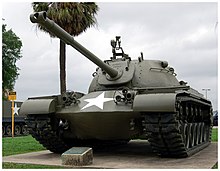
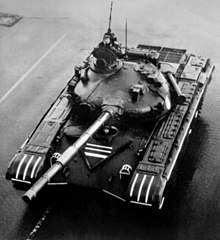
An increasing variety of anti-tank weapons and the perceived threat of anuclear warprioritized the need for additional armor. The additional armour prompted the design of even more powerful guns.[1]The main battle tank thus took on the role the British had once called the 'Universal tank', filling almost all battlefield roles. Typical main battle tanks were well armed and highly mobile, but cheap enough to be built in large numbers. The classic main battle tanks of the 1950s were the BritishCenturion,the SovietT-55series, and the USM46through theM48 series,which saw continuous updates throughout the Cold war. For example, the Centurion began life with the highly effective17-pounder (76.2 mm) gun,but was upgraded to 20 pounder (84 mm) and then 105 mm main armament by 1959, with improved fire control and new engines.
The Soviet T-55 started with a 100 mm gun, but has been upgraded with both 115 mm and 125 mm guns, much improved fire control systems, new engines, track, etc. The M46 series evolved through to theM60series. The first Soviet main battle tank was theT-64[2]while the first American MBT was the M60 combat tank.[3]
These vehicles and their derivatives formed the bulk of the armoured forces of NATO and the Warsaw Pact throughout theCold War;many remain in use in the 21st century.
Light tanks[edit]

Light tanks,such as the SovietPT-76,maintained limited roles such as amphibious reconnaissance, support ofAirborne units,and in rapid intervention forces which were not expected to face enemy tanks. The USM551 Sheridanhad similar strengths and weaknesses, but could also be airdropped, either by parachute orLAPES.The value of light tanks for scouting has been diminished greatly by helicopters, although many continued to be fielded. During the early Cold War the US wielded the more conventionalM41 Walker Bulldog.[4]From the mid-late Cold WarInfantry Fighting Vehiclessuch as the SovietBMPand USM2 Bradleyto an extent replaced light tanks, being similar to the extent that they are lesser armed and armored but lighter and cheaper than main battle tanks. At the end of the Cold War light tank-likearmored carswere designed such as theSouth AfricanRooikatand the ItalianB1 Centaurowhich have seen service in the post-Cold War era.
Heavy tanks[edit]

Heavy tanks such as theT-10continued to be developed and fielded along with medium tanks until the 1960s and 1970s, when the development of anti-tank guided missiles and powerfultank gunsrendered them ineffective. The combination of largehigh-explosive anti-tank(HEAT) warheads, with a long effective range relative to a tank gun, and with high accuracy, meant that heavy tanks could no longer function in a stand-off, or overwatch role; much cheaper antitank guided missiles could fill this role as well. Medium tanks were just as vulnerable to the new missiles, but could be fielded in greater numbers and had higher battlefield mobility.
Development of antitank weapons and countermeasures[edit]

After theYom Kippur Warof 1973, when Israeli tanks were destroyed in large quantities by man-portablewire-guided missiles(ATGMs) fired by Egyptian infantry, concerns were raised on the vulnerability of tanks on the battlefield to antitank weapons. Subsequent analysis showed that Israeli forces had underestimated their opponents during the first phases of the war; their all-tank tactics ignored the newfound ability of Infantry armed with cheap AT weapons to stop tanks. Tactically, there was renewed recognition for the need for combined-arms tactics. This led to greater mechanization of Infantry and advanced artillery tactics and warheads. Tanks alone were vulnerable to Infantry, but a combined team of tanks, mechanized Infantry, and mechanized artillery could still win in the new environment.
In 1974, the United States initiated a program to modernise its existing tank fleet and start real mass production of the M60A1, and later the M60A3; at the same time the M1 was developed. Budgets for tank design and production picked up during the administration of presidentRonald Reagan,following tensions between the United States and the Soviet Union.[citation needed]
In response to infantry-portable and vehicle-mounted ATGMS, ever more capablevehicle armourwere developed.Spaced armour,composite,explosive reactive armour,andactive protection systems—like the RussianShtora,Drozd,andArena—were added to old and new tanks. Despite these improvements the larger missiles remained highly effective against tanks.
Missile-armed tanks[edit]


During the latter half of the 20th century, some tanks were armed withATGMs(Anti-Tank Guided Missiles) which could be launched through asmoothboreor (in the case of "Shillelagh" ) a rifled main gun barrel with a provision to prevent imparting "spin" to the missile. In the U.S., the M60A2,M551 Sheridan,and prototype MBT-70, with 152 mm barrel/launchers used theShillelaghinfrared-guided missile.
During WWII a few tanks designs such as theM4 Shermanwere modified tocarry unguided rocketson the turret in addition to their main gun. This concept was to a limited extent carried into the Cold War with ATGMs; examples include the French AMX-13 and the Swedish Strv 81 (the Swedish version of the British centurion), both modified to carry SS.11 missiles on the top and sides of the turret, respectively.
The MBT-70 was cancelled prior to production due to high cost, and superseded by theM1 Abrams,which used a conventional gun. The M551 and the M60A2 were widely considered disappointing due to problems of overall complexity, sensitive advanced electrical systems (some components of which involved the Shillelagh guidance system) and issues related to the conventional rounds with combustible cases, though the Sheridan would serve into the 1990s before finally being withdrawn. The M60A2's were eventually replaced by M60A3s using conventional 105 mm guns.
TheSoviet Unionput gun-launched missiles into service in the mid-1970s, which continue to be used inCISforces. Tanks capable of firing gun-launched missiles in Russian service include theT-72,T-80,T-90,and upgradedT-55(T-55AM2).Ukrainealso employs missile-armedT-64,T-80,andT-84tanks.
History in the Cold War[edit]
Korean War[edit]
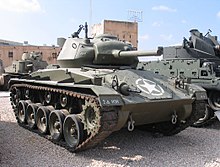
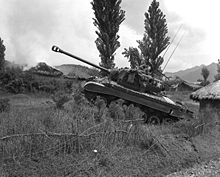

In theKorean WarM24 Chaffeeswere the first U.S. tanks to fight theNorth KoreanT-34-85s.The Chaffee fared poorly against these much better-armed and armored medium tanks. Chaffees were more successful later in the war in their reconnaissance role, supported by heavier tanks such as theM4 Sherman,M26 Pershing,andM46 Patton.
The heavier but older Pershing was deemed unsatisfactory due to its inferior mobility, which was unsuitable for a medium tank role as it used the same engine that powered the much lighter M4 Sherman, and 1949, the upgraded M26 received a new power plant and a main gun withbore evacuator,and theM46 Pattondesignation. Less than a thousand were upgraded to M46 standard.
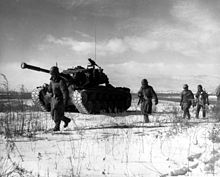
On 8 August 1950 the first M46 Pattons landed in South Korea. The tank proved superior to the much lighter North KoreanT-34-85,which were encountered in relatively small numbers. By the end of 1950, 200 M46 Pattons had been fielded, forming about 15% of US tank strength in Korea; the balance of 1,326 tanks shipped to Korea during 1950 included 679 M4A3 Shermans, 309 M26 Pershings, and 138 M24 Chaffee light tanks.[5]Subsequent shipments of M46 and M46A1 Pattons allowed all remaining M26 Pershings to be withdrawn during 1951, and most Sherman equipped units were also reequipped.[6]
By 1953 the M24 Chaffees were completely replaced by theM41 Walker Bulldog,which was rushed to the battlefield by the U.S. Army. The Walker Bulldog was too late to see combat during theKorean War.

BritishCenturion tanks,assisted byCromwellsin the reconnaissance role, arrived in Korea in late 1950. The UK tanks had to operate in much colder[citation needed]conditions than their usual deployments on theNorth German Plain.The Centurions covered the retreat at thebattle of the Imjin Riverwith the tanks from CSquadron,8th Hussars,under the command of Major Henry Huth and by 55 Squadron,Royal Engineers.The British position on the Imjin river "was deemed safe" but vulnerable in case of an attack which prove to be case,[7]and the tanks were able stand their ground in the battle. The Centurions were also inOperation Commandoand were used to capture high ground earning praise from the commander of I Corps. Thereafter the war was largely static and the Centurions were used as artillery against the infantry attacks which generally happened at night.[8]
Interwar[edit]
TheM47 Pattonwas intended to replace the M46 Patton and M4 Sherman tanks. It had a 90 mm gun and a crew of 5. Despite it being the primary tank of the US it never saw combat while in US service. In early 1951, the U.S. initiated the design of the M48 Patton, designated the T-48 with a 90 mm gun.[9]The T48 featured a new turret, new redesigned hull and an improved suspension. The hull machine gunner position was removed, reducing the crew to 4. On 2 April 1953, the Ordnance Technical Committee Minutes (OTCM), standardized the last of the Patton series tanks as the M48 Patton.
Nearly 12,000 M48s were built from 1952 to 1959. The early designs, up to the M48A2, were powered by a gasoline 12-cylinder engine which was coupled with an auxiliary 8-cylinder engine. The gas engines gave the tank a short operating range and were prone to catching fire when hit; this version was considered unreliable.

TheM103 heavy tankwas manufactured at theDetroit Arsenal Tank Plantand the first units were accepted in 1957.
The M103 was designed to counterSovietheavy tanks. Its long-ranged 120 mm gun was designed to hit enemy tanks at extreme distances, although it was never used in combat. Of the 300 M103s built, most went to the Marines.[10]The tank was relatively underpowered and the drive systems were fragile. The turret of the M103 was larger than that of the M48 or the M60 to make room for the huge 120 mm gun and the two loaders assigned to it, in addition to the gunner and the commander. The driver sat in the hull. The gun was capable of elevation from +15 to -8 degrees.
The British introduced theirHeavy Gun Tank F214 Conquerorwith the same 120mm gun as the M103 into service in 1955. It stayed in service until 1960; the upgrading of Centurion tank to the L7 105mm gun having removed its purpose.
While the US Army deactivated its heavy armor units with the reception of the new M60 series main battle tanks in 1960, the remaining M103s stayed within the US Marine Corps inventory until they began receiving the M60 series MBT. With the disappearance of the heavy tank from US forces came the full acceptance of themain battle tankin 1960 for the US Army, and later for the US Marine Corps.[11]
The British successor to Centurion wasChieftainin 1966. Chieftain was heavily armoured and had a 120mm gun following a doctrine of long range fire and survivability that would be needed against the more numerous Warsaw Pact tanks in the event of an invasion of West Germany.
Vietnam War era[edit]

Tanks for the most part, saw limited action in Vietnam compared to the heavy fighting in Korea, but even in the Vietnam jungle the M48 Patton saw tank-on-tank duels.

Over 600 Pattons would be deployed with US Forces during the war.[13]The initial M48s landed with the US Marines in 1965.[14]Three U.S. Army battalions also arrived in Southern Vietnam. Each battalion consisted of approximately fifty seven tanks. M48s were also used by Armored Cavalry Squadrons in Vietnam, until replaced byM551 Sheridantanks. The M67A1flamethrowertank (nicknamed theZippo) was an M48 variant used in Vietnam.

Many of the M48A3 Pattons were turned over to theArmy of the Republic of Vietnam(ARVN) forces, in particular creating the ARVN 20th Tank Regiment; which supplemented theirM41 Walker Bulldogunits. During theNorth Vietnamese Army(NVA) Easter Offensive in 1972, tank clashes between NVAT-54/PT-76and ARVN M48/M41 units became commonplace.[14]
The M48s performed admirably[15]in Vietnam in the infantry-support role. However, there were few actual tank versus tank battles. The M48s provided adequate protection for its crew from small arms, mines, androcket-propelled grenades.

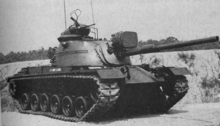
The plans were laid in the US in the late fifties, for a tank with a 105 mm main gun and a redesigned hull offering better armor protection. The resultingM60largely resembled the M48 it was based on, but has significant differences.
Initially, the M60 had essentially the same turret shape as the M48, but this was subsequently replaced with a distinctive "needlenose" design that minimized frontal cross-section to enemy fire. It was the last American tank to feature either theM60 machine gunor an escape hatch under the hull. The new vehicle was put into production in 1959, and entered service in 1960. Over 15,000 M60s (all variants) were constructed.

Development of the AmericanM551 Sheridanlight tank was initiated following the appearance of the Soviet amphibious PT-76 light tank.
The need for even lighter weight to make the tank transportable presented the design with a particularly difficult problem; guns capable of defeating modern tanks at reasonable ranges were so large that they demanded a large vehicle to carry them, so large that they couldn't be used as a "light" tank. The use of HEAT rounds instead of conventional penetrating ammunition could address this, but HEAT rounds work better at larger calibers. Gun weight is typically the product of caliber andmuzzle velocity,so in the case of the XM551 they sacrificed the muzzle velocity, producing the low-velocity but relatively large-caliber 152 mmM81.HEAT rounds fired by the M81 could defeat any contemporary tank at shorter ranges, but its low velocity made it difficult to use at longer ranges, especially against moving targets. The large low-velocity gun was also ideal for infantry support, where higher performance anti-tank guns would often fire right through soft targets and their small-caliber guns left little room for explosive filler. TheM551 Sheridantank would thus be ideal for both direct fire support as well as short-distance anti-tank engagements.
The only niche where theM551 Sheridanwas not ideal was the medium and long-range anti-tank engagement. The muzzle velocity was so low that a HEAT round fired at longer ranges would have to be "lofted", making aiming difficult, and the flight time would be so long that a moving target would be very difficult to hit. However, it appeared there was a solution to this problem by equipping the tank with gun-firedanti-tank missiles.For longer range engagements a missile would be fired instead of a HEAT round, and although its velocity would also be relatively slow, the guidance system would make a hit highly likely anyway. TheM551 Sheridanappeared to offer the best of both worlds; for infantry support the large calibre gun allowed it to fire full-sized artillery rounds and canister shot, while also giving it reasonable short-range anti-tank performance from the same gun.
The M551 Sheridan had a steel turret and aluminum hull. The M551 had excellent mobility, able to run at speeds up to 45 miles per hour (72 km/h), which at that time was unheard of for a tracked vehicle. Swimming capability was provided by a flotation screen. The Sheridan entered service in June 1967 and was deployed to Vietnam in 1969. More than 1,600 M551s were built between 1966 and 1970.
The Sheridan was plagued by issues in service; mainly relating to the gun. Firing the gun would often adversely affect the delicate electronics, so the missile and guidance system was omitted from vehicles deployed to Vietnam. The gun had problems with cracks developing near the breech. The gun also was criticized for having too much recoil for the vehicle weight, the second and even third road wheels coming clear off the ground when the main gun fired. The aluminum hull was highly vulnerable to mines.
The Sheridan saw extensive action in the Vietnam War. A 1969 evaluation of the vehicles found the M551 was employed in reconnaissance, night patrol and road clearing, accumulating 39,455 road miles and 520 combat missions, with a ready rate of 81.3 percent. Despite vulnerability to rockets and mines, it was judged worth applying modifications and equip all cavalry squadrons with the Sheridan.[16]
During the 1960s, the US andWest Germanyentered a joint project for a new tank common to both armies and intended to enter service in the 1970s. TheMBT-70project was technically advanced with sophisticated suspension, a low silhouette, spaced armor and advanced gun systems but suffered from excessive costs. Both partners mutually agreed to end the joint project in 1970.
The M60 tank was upgraded and designated the M60A2. It featured an entirely new low-profile turret with a commander's machine-guncupolaon top, featured a 152 mm gun, which fired conventional rounds as well asguided missiles.The M60A2 proved a disappointment, though technical advancements would pave the way for future tanks. The Shillelagh/M60A2 system was phased out from active units by 1981, and the turrets scrapped. Most of the M60A2 tanks were rebuilt as M60A3s with a 105mm gun.[17]
Post-Vietnam[edit]
The US Army began to phase out the Sheridan in 1978, replacing these with theM3 Bradleycavalry fighting vehicle.


The GermanLeopardtank, another 105mm armed tank, was introduced in 1965. It was sold widely to several nations in NATO as well as worldwide. It was followed in 1979 by theLeopard 2with a 120mmsmoothboregun.
In 1976, prototypes of a new tank which became theM1 Abramswere delivered by Chrysler Defense andGeneral Motorsarmed with a 105 mm rifled gun. The Chrysler Defense design was selected for development as the M1. In 1979,General DynamicsLand Systems Division purchased Chrysler Defense. TheM1 Abramscame from the diverted funds from the over budget and impracticalMBT-70and XM815 projects.
The M1 was the first of its kind. It feature a low profile turret and for the first time ever on a tank, compositeChobham armor.Despite all these advances, the Abrams still retained the 4-man crew of the M60 tank as theautoloaderwas considered unproven and risky. It was armed with the same L7-derived 105mm gun as the M60. Over 3200M1 Abramswere produced and first entered US Army service in 1980. About 6,000 upgradedM1A1 Abramswere produced and used the German 120 mm smoothbore gun, improved armor, and aCBRNprotection system.
As the Abrams entered service in the 1980s, they would operate alongside M60A3 tanks. These exercises usually took place in Western Europe, especially West Germany, but also in some other countries like South Korea. During such training, Abrams crews honed their skills for use against the Soviet Union. However, by 1991 the USSR had collapsed and the Abrams would have its trial by fire in the Middle East.
The BritishFV4030/4 Challenger,continuing with a 120mm rifled gun and protected by Chobham armor entered service in 1983.
Gulf War/Iraq war[edit]

The Gulf War saw the US Marines still deploying obsolete M60 tanks while the rest of the tank forces had Abrams. The Iraqi forces were initially regular army units, equipped with tanks such asT-54/55tanks and T-62s. The Coalitionmain battle tanks,such as the U.S.M1 Abrams,BritishChallenger 1,and KuwaitiM-84AB were vastly superior to the ChineseType 69and domestically built T-72 tanks used by the Iraqis, with crews better trained and armoured doctrine better developed.

The majority of Iraqi armored forces still used old ChineseType 59sandType 69s,Soviet-madeT-55sfrom the 1950s and 1960s, and some poor qualityAsad Babil tanks(domestically assembled tank based on Polish T-72 hulls with other parts of mixed origin). These machines were not equipped with up-to-date equipment, such asthermal sightsorlaser rangefinders,and their effectiveness in modern combat was very limited.
The Iraqis failed to find an effective countermeasure to the thermal sights andsabot roundsused by Coalition armour. This equipment enabled them to engage and destroy Iraqi tanks from more than three times the range that Iraqi tanks could engage coalition tanks. Some Iraqi crews even fired training rounds at the U.S. and British tanks. These rounds (purchased in great number during theIran–Iraq Wardue to their inexpensive cost) had soft steelpenetratorsand thus no hope of penetrating the advancedChobham Armourof the Coalition tanks.
In the Iraqi war in 2003, an Iraqi division the 6th Armored Division of theIraqi Army.[18]which was equipped with T-55s andBMP-1sdefending the control of key bridges over the Euphrates River and the Saddam Canal at Nasiriyah, were decimated by US Marines withM1 Abrams,and the division as a unit rendered incapable for combat during theBattle of Nasiriyahin March 2003, during the invasion.
In addition to theT-54/55andT-62tanks that Iraq had, the most feared to US armoured forces were theT-72tanks in the Iraqi forces. OnlyRepublican Guarddivisions were equipped with Iraqi-modified T-72s. Many of the Iraqi T-72s were dug-in or hidden in groves, and then used to ambush the US or British tanks. In the war, the Iraqi T-72s were the preferred target for Apache helicopters and A-10s, in an attempt to diminish the combat power ofRepublican Guarddivisions. The only chance for theAsad BabilT-72s against American tanks was to lure them to close range combat, or trying to ambush them from dug-in positions.[19]

But even in those conditions, the M1s usually prevailed, as proven in circumstances like theBattle of Baghdad,and the drive to the capital, where dozens of Iraqi MBTs were obliterated,[20]or nearMahmoudiyah,south of Baghdad, April 3, 2003, (Iraqi Freedom) when US tanks engaged their counterparts from just 50 yards, shattering seven enemy T-72s without losses.[21]The Lion of BabylonT-72was utterly outclassed by theM1 Abrams,the Challenger and by any other contemporary Western main battle tank during the 2003 invasion of Iraq.[22]
See also[edit]
- History of the tank
- Tanks in World War I
- Comparison of World War I tanks
- Tanks of the interwar period
- Tanks in World War II
- Comparison of early World War II tanks
- Post-Cold War Tanks
References[edit]
- ^Front Cover Thomas W. Zarzecki (2002).Arms diffusion: the spread of military innovations in the international system.Psychology Press. p. 212.ISBN0-415-93514-8.Retrieved5 April2011.
- ^T-64 manual ( "Танк Т-64А. Техническое описание и инструкция по эксплуатации. 1984" ) state T-64 as "main battle" tank, while previous T-62 and T-55 (in corresponding military manuals, like "Танк Т-62. Руководство по материальной части и эксплуатации. 1968" ) stated as "medium" tanks
- ^MIL-T-45308 state "Tank, Main Battle, 105MM Gun, M60", while MIL-T-45148 state "TANK, COMBAT, FULL-TRACKED, 90MM GUN, M48A2"
- ^Department of the Army Technical Manual FM 17-80:Tanks, 76-mm Gun M41 and M41A1.Washington DC: Department of the Army. 1956. p. 4.
- ^Steven J. Zaloga "M26/M46 Pershing Tank 1943–1953"ISBN1-84176-202-4pp.39-40
- ^Donald W Boose Jr. "US Army Forces in the Korean War 1950-53"ISBN1-84176-621-6pp.52,75-86
- ^Hastings, Max (1987).The Korean War.Simon & Schuster. p. 253.ISBN978-0-671-52823-2.
- ^Centurion 1943-2003p18-20
- ^Hunnicutt/p. 85 & 152
- ^Hunnicut/Firepower
- ^Hunnicutt[page needed]
- ^Starry
- ^Starry/Hunnicutt
- ^abDunstan
- ^Nolan
- ^[1][dead link]Washer evaluation 1969.
- ^Patton Mania M60
- ^RJ Lee,Key Components of the Iraqi Ground Forces, 2002[permanent dead link]
- ^Scales, page 269: "As TF 1-37th Armor crossed over the ridge into the heart of the Iraqi defensive zone, the Iraqi commander's carefully disposed rear-slope defense stripped Dyer's tanks of their range advantage. Within 1,000 meters, a row of dug-in T-72s and BMPs suddenly appeared below the crest. All were hull-down in prepared positions behind thick dirt walls (thus disproving the much-quoted u.s. truism that soviet tanks had difficulties in achieving 'hull down' position). Now the Americans were well within Iraqi killing range, and although the Soviet-made night sights were markedly inferior, things could still get very dicey."
- ^Scales, page 270: "After the war they (TF 1-37th) returned to count the burned-out hulks of 76 T-72s, 84 BMPs, 3 air defense artillery pieces, 8 howitzers, 6 command vehicles, 2 engineer vehicles, and myriad of trucks."
- ^Conroy & Mars, p. 158
- ^ТАНКИ ИРАКСКОЙ АРМИИ[Iraqi Army Tanks].otvaga2004.narod.ru(in Russian). December 29, 2009. Archived fromthe originalon September 5, 2009.
